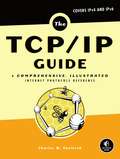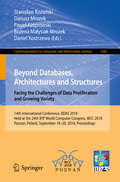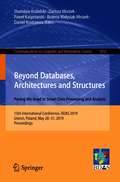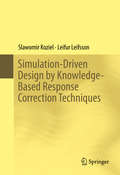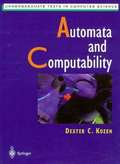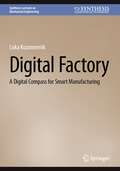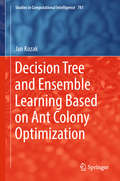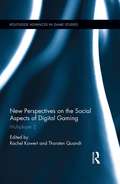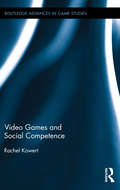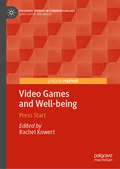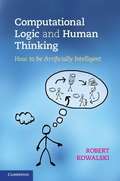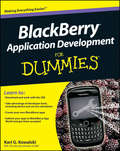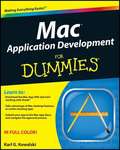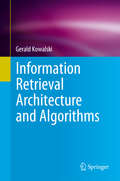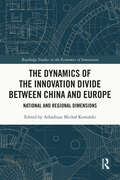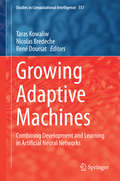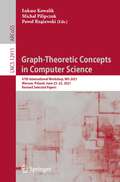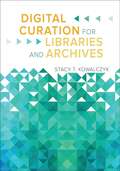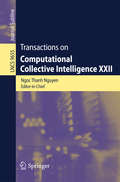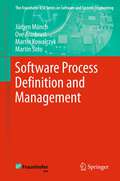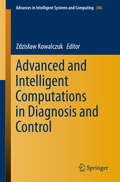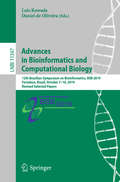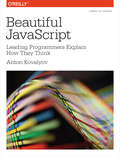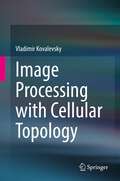- Table View
- List View
The TCP/IP Guide
by Charles M. KozierokFrom Charles M. Kozierok, the creator of the highly regarded www.pcguide.com, comes The TCP/IP Guide. This completely up-to-date, encyclopedic reference on the TCP/IP protocol suite will appeal to newcomers and the seasoned professional alike. Kozierok details the core protocols that make TCP/IP internetworks function and the most important classic TCP/IP applications, integrating IPv6 coverage throughout. Over 350 illustrations and hundreds of tables help to explain the finer points of this complex topic. The book’s personal, user-friendly writing style lets readers of all levels understand the dozens of protocols and technologies that run the Internet, with full coverage of PPP, ARP, IP, IPv6, IP NAT, IPSec, Mobile IP, ICMP, RIP, BGP, TCP, UDP, DNS, DHCP, SNMP, FTP, SMTP, NNTP, HTTP, Telnet, and much more.The TCP/IP Guide is a must-have addition to the libraries of internetworking students, educators, networking professionals, and those working toward certification.
Beyond Databases, Architectures and Structures. Facing the Challenges of Data Proliferation and Growing Variety: 14th International Conference, BDAS 2018, Held at the 24th IFIP World Computer Congress, WCC 2018, Poznan, Poland, September 18-20, 2018, Proceedings (Communications in Computer and Information Science #928)
by Stanisław Kozielski Dariusz Mrozek Paweł Kasprowski Bożena Małysiak-Mrozek Daniel KostrzewaThis book constitutes the refereed proceedings of the 14th International Conference entitled Beyond Databases, Architectures and Structures, BDAS 2018, held in Poznań, Poland, in September 2018, during the IFIP World Computer Congress.It consists of 38 carefully reviewed papers selected from 102 submissions. The papers are organized in topical sections, namely big data and cloud computing; architectures, structures and algorithms for efficient data processing; artificial intelligence, data mining and knowledge discovery; text mining, natural language processing, ontologies and semantic web; image analysis and multimedia mining.
Beyond Databases, Architectures and Structures. Paving the Road to Smart Data Processing and Analysis: 15th International Conference, BDAS 2019, Ustroń, Poland, May 28–31, 2019, Proceedings (Communications in Computer and Information Science #1018)
by Stanisław Kozielski Dariusz Mrozek Paweł Kasprowski Bożena Małysiak-Mrozek Daniel KostrzewaThis book constitutes the refereed proceedings of the 15th International Conference entitled Beyond Databases, Architectures and Structures, BDAS 2019, held in Ustroń, Poland, in May 2019. It consists of 26 carefully reviewed papers selected from 69 submissions. The papers are organized in topical sections, namely big data and cloud computing; architectures, structures and algorithms for efficient data processing and analysis; artificial intelligence, data mining and knowledge discovery; image analysis and multimedia mining; bioinformatics and biomedical data analysis; industrial applications; networks and security.
Simulation-Driven Design by Knowledge-Based Response Correction Techniques
by Slawomir Koziel Leifur LeifssonFocused on efficient simulation-driven multi-fidelity optimization techniques, this monograph on simulation-driven optimization covers simulations utilizing physics-based low-fidelity models, often based on coarse-discretization simulations or other types of simplified physics representations, such as analytical models. The methods presented in the book exploit as much as possible any knowledge about the system or device of interest embedded in the low-fidelity model with the purpose of reducing the computational overhead of the design process. Most of the techniques described in the book are of response correction type and can be split into parametric (usually based on analytical formulas) and non-parametric, i. e. , not based on analytical formulas. The latter, while more complex in implementation, tend to be more efficient. The book presents a general formulation of response correction techniques as well as a number of specific methods, including those based on correcting the low-fidelity model response (output space mapping, manifold mapping, adaptive response correction and shape-preserving response prediction), as well as on suitable modification of design specifications. Detailed formulations, application examples and the discussion of advantages and disadvantages of these techniques are also included. The book demonstrates the use of the discussed techniques for solving real-world engineering design problems, including applications in microwave engineering, antenna design, and aero/hydrodynamics.
Automata and Computability
by Dexter C. KozenThis textbook provides undergraduate students with an introduction to the basic theoretical models of computability. Students who have already some experience with elementary discrete mathematics will find this a well-paced first course. Plenty of exercises are provided, ranging from the easy to the challenging.
Closer: Performance, Technologies, Phenomenology
by Susan KozelIn Closer, Susan Kozel draws on live performance practice, digital technologies, and the philosophical approach of phenomenology. Trained in dance and philosophy, Kozel places the human body at the center of explorations of interactive interfaces, responsive systems, and affective computing, asking what can be discovered as we become closer to our computers--as they become extensions of our ways of thinking, moving, and touching. Performance, Kozel argues, can act as a catalyst for understanding wider social and cultural uses of digital technology. Taking this one step further, performative acts of sharing the body through our digital devices foster a collaborative construction of new physical states, levels of conscious awareness, and even ethics. We re-encounter ourselves and others through our interactive computer systems. What we need now are conceptual and methodological frameworks to reflect this. Kozel offers a timely reworking of the phenomenology of French philosopher Maurice Merleau-Ponty. This method, based on a respect for lived experience, begins by listening to the senses and noting insights that arrive in the midst of dance, or quite simply in the midst of life. The combination of performance and phenomenology offered by Closer yields entwinements between experience and reflection that shed light on, problematize, or restructure scholarly approaches to human bodies using digital technologies. After outlining her approach and methodology and clarifying the key concepts of performance, technologies, and virtuality, Kozel applies phenomenological method to the experience of designing and performing in a range of computational systems: telematics, motion capture, responsive architectures, and wearable computing. The transformative potential of the alchemy between bodies and technologies is the foundation of Closer. With careful design, future generations of responsive systems and mobile devices can expand our social, physical, and emotional exchanges.
Digital Factory: A Digital Compass for Smart Manufacturing (Synthesis Lectures on Mechanical Engineering)
by Luka KozamernikThe Digital Factory is a comprehensive guide for leaders in the manufacturing sector looking to navigate the complex digital transformation landscape. Digitalization has become crucial to any company's success in today's fast-paced business world. However, making sense of the plethora of information on approaching digitalization can be challenging, leaving many leaders needing clarification. The pressure to make the right decisions can be overwhelming, with various groups advocating their interests. Without a clear vision and understanding of digital transformation, leaders may lack confidence in making the right company decisions. And with access to specific and valuable knowledge about digital transformation, achieving optimal returns for the company can be more accessible. This book is designed to empower leaders in the manufacturing sector to overcome these challenges.
Decision Tree and Ensemble Learning Based on Ant Colony Optimization (Studies in Computational Intelligence #781)
by Jan KozakThis book not only discusses the important topics in the area of machine learning and combinatorial optimization, it also combines them into one. This was decisive for choosing the material to be included in the book and determining its order of presentation. Decision trees are a popular method of classification as well as of knowledge representation. At the same time, they are easy to implement as the building blocks of an ensemble of classifiers. Admittedly, however, the task of constructing a near-optimal decision tree is a very complex process. The good results typically achieved by the ant colony optimization algorithms when dealing with combinatorial optimization problems suggest the possibility of also using that approach for effectively constructing decision trees. The underlying rationale is that both problem classes can be presented as graphs. This fact leads to option of considering a larger spectrum of solutions than those based on the heuristic. Moreover, ant colony optimization algorithms can be used to advantage when building ensembles of classifiers.This book is a combination of a research monograph and a textbook. It can be used in graduate courses, but is also of interest to researchers, both specialists in machine learning and those applying machine learning methods to cope with problems from any field of R&D.
New Perspectives on the Social Aspects of Digital Gaming: Multiplayer 2 (Routledge Advances in Game Studies)
by Rachel Kowert Thorsten QuandtExpanding on the work in the volume Multiplayer, this new book explores several other areas related to social gaming in detail. The aim is to go beyond a typical "edited book" concept, and offer a very concise volume with several focal points that are most relevant for the current debate about multiplayer games, both in academia and society. As a result, the volume offers the latest research findings on online gaming, social forms of gaming, identification, gender issues and games for change, primarily applying a social-scientific approach.
Video Games and Social Competence (Routledge Advances in Game Studies)
by Rachel KowertDespite their popularity, online video games have been met with suspicion by the popular media and academic community. In particular, there is a growing concern that online video game play may be associated with deficits in social functioning. Due to a lack of empirical consistency, the debate surrounding the potential impact of online video game play on a user’s sociability remains an active one. This book contributes to this debate by exploring the potential impact of online video game involvement on social competence outcomes, theoretically and empirically. Through empirical research, Kowert examines the relationships between online video game involvement, social goals, and social skills and discusses the underlying mechanisms of these effects.
Video Games and Well-being: Press Start (Palgrave Studies in Cyberpsychology)
by Rachel KowertThis book examines how video game mechanics and narratives can teach players skills associated with increased psychological well-being. It integrates research from psychology, education, ludology, media studies, and communication science to demonstrate how game play can teach skills that have long been associated with increased happiness and prolonged life satisfaction, including flexible thinking, openness to experience, self-care, a growth mindset, solution-focused thinking, mindfulness, persistence, self-discovery and resilience. The chapters in this volume are written by leading voices in the field of game studies, including researchers from academia, the video gaming industry, and mental health practitioners paving the way in the field of “geek therapy.” This book will advance our understanding of the potential of video games to increase our psychological well-being by helping to mitigate depression, anxiety, and stress and foster persistence, self-care, and resilience.
Computational Logic and Human Thinking
by Robert KowalskiThe practical benefits of computational logic need not be limited to mathematics and computing. As this book shows, ordinary people in their everyday lives can profit from the recent advances that have been developed for artificial intelligence. The book draws upon related developments in various fields from philosophy to psychology and law. It pays special attention to the integration of logic with decision theory, and the use of logic to improve the clarity and coherence of communication in natural languages such as English. This book is essential reading for teachers and researchers who may be out of touch with the latest developments in computational logic. It will also be useful in any undergraduate course that teaches practical thinking, problem solving or communication skills. Its informal presentation makes the book accessible to readers from any background, but optional, more formal, chapters are also included for those who are more technically oriented.
BlackBerry Application Development For Dummies
by Karl G. KowalskiThe first introductory book to developing apps for the BlackBerry If you're eager to start developing applications for the BlackBerry, then this is the hands-on book for you! Aimed directly at novice developers, this beginner guide introduces you to the basics of the BlackBerry API and shows you how to create a user interface, store and sync data, optimize code, manage applications, connect to a network, create enterprise applications using MDS Studio, create Web content, and more. Packed with examples, this straightforward guide takes you from the beginning of the BlackBerry application cycle completely to the end. Guides you through the process of developing applications for the BlackBerry Presents an overview of the BlackBerry, including detailed explanations on the architecture and an in-depth look at the programming API Introduces MDS Studio, which is the latest tool from RIM for building enterprise applications Offers novice developers numerous reusable code examples that can be immediately used Explains how to store and sync data, optimize code, manage applications, connect to networks, and more BlackBerry Application Development For Dummies puts you well on your way to creating BlackBerry apps the fun and easy way!
Mac Application Development For Dummies
by Karl G. KowalskiThe App Store extends to the Mac desktop! Developers: here's how join the funIf you love your desktop Mac and want to enjoy the fun and challenge of developing Mac apps for the App Store, here's your chance to get started. This fun, full-color guide shows you how to create killer Mac apps on, and for, a desktop Mac. The book takes you step by step through the development of two apps while you get up to speed on the Mac App SDK, Xcode 4, how a Mac app runs, cryptography, views, and much more.Shows you how to download the Mac App SDK, set up Xcode 4, and how Mac apps runTakes you step by step through the development of two Mac desktop appsExplains views, view controllers, interface objects, gesture recognizers, cryptography, security, network awareness, and much moreThe App Store for the Mac desktop is the next big thing for developers! Be ready with this book at your disposal.Note: Apple's iOS SDK tools are only accessible on Intel-powered Mac and MacBook devices.
Information Retrieval Architecture and Algorithms
by Gerald KowalskiThis text presents a theoretical and practical examination of the latest developments in Information Retrieval and their application to existing systems. By starting with a functional discussion of what is needed for an information system, the reader can grasp the scope of information retrieval problems and discover the tools to resolve them. The book takes a system approach to explore every functional processing step in a system from ingest of an item to be indexed to displaying results, showing how implementation decisions add to the information retrieval goal, and thus providing the user with the needed outcome, while minimizing their resources to obtain those results. The text stresses the current migration of information retrieval from just textual to multimedia, expounding upon multimedia search, retrieval and display, as well as classic and new textual techniques. It also introduces developments in hardware, and more importantly, search architectures, such as those introduced by Google, in order to approach scalability issues. About this textbook: A first course text for advanced level courses, providing a survey of information retrieval system theory and architecture, complete with challenging exercisesApproaches information retrieval from a practical systems view in order for the reader to grasp both scope and solutionsFeatures what is achievable using existing technologies and investigates what deficiencies warrant additional exploration
The Dynamics of the Innovation Divide between China and Europe: National and Regional Dimensions (Routledge Studies in the Economics of Innovation)
by Arkadiusz Michał KowalskiThis book examines the problem of the innovation divide in the world economy, and convergence in innovation performance between leaders and followers, analysed through the prism of Chinese experiences, and explored from an European Union (EU) perspective. The rationale for research conducted in this book is an observation of a significant change in the geography of world innovation, reflected in the emergence of innovation hubs in developing countries and in the shift of manufacturing activity, including high and medium-high technology industries, to emerging economies, mainly China. The book analyses the factors of Chinese innovation success in recent decades, such as: China’s science, technology and innovation policy, increased R&D expenditures, human capital development and the development of clusters and highly specialized industries. It also focuses on the challenges for developed European economies, which are being at risk of losing their knowledge-related sources of competitive advantage. It also offers recommendations for future policy actions. The book’s analysis goes beyond a cross-country comparison, taking into account a regional perspective. The reason for this regional dimension is the increasingly recognized importance of proximity in stimulating innovation processes, and an observed strong geographical polarization of innovation activity at specific regions seen in the emergence of clusters, particularly visible in China. The monograph will provide an up-to-date reference for academics and students across a variety of disciplines. It will be of particular interest to researchers in the area of innovation and practitioners doing business in China, as well as policymakers at international, national and regional levels involved in designing and implementing innovation policy.
Growing Adaptive Machines
by Taras Kowaliw Nicolas Bredeche René DoursatThe pursuit of artificial intelligence has been a highly active domain of research for decades, yielding exciting scientific insights and productive new technologies. In terms of generating intelligence, however, this pursuit has yielded only limited success. This book explores the hypothesis that adaptive growth is a means of moving forward. By emulating the biological process of development, we can incorporate desirable characteristics of natural neural systems into engineered designs and thus move closer towards the creation of brain-like systems. The particular focus is on how to design artificial neural networks for engineering tasks. The book consists of contributions from 18 researchers, ranging from detailed reviews of recent domains by senior scientists, to exciting new contributions representing the state of the art in machine learning research. The book begins with broad overviews of artificial neurogenesis and bio-inspired machine learning, suitable both as an introduction to the domains and as a reference for experts. Several contributions provide perspectives and future hypotheses on recent highly successful trains of research, including deep learning, the Hyper NEAT model of developmental neural network design, and a simulation of the visual cortex. Other contributions cover recent advances in the design of bio-inspired artificial neural networks, including the creation of machines for classification, the behavioural control of virtual agents, the desi gn of virtual multi-component robots and morphologies and the creation of flexible intelligence. Throughout, the contributors share their vast expertise on the means and benefits of creating brain-like machines. This book is appropriate for advanced students and practitioners of artificial intelligence and machine learning.
Graph-Theoretic Concepts in Computer Science: 47th International Workshop, WG 2021, Warsaw, Poland, June 23–25, 2021, Revised Selected Papers (Lecture Notes in Computer Science #12911)
by Łukasz Kowalik Michał Pilipczuk Paweł RzążewskiThis book constitutes the proceedings of the 47th International Workshop on Graph-Theoretic Concepts in Computer Science which was held during June 23–25, 2021. The conference was planned to take place in Warsaw, Poland, but changed to an online event due to the COVID-19 pandemic. The 30 full papers included in this volume were carefully reviewed and selected from 73 submissions. The conference aims to merge theory and practice by demonstrating how concepts from graph theory can be applied to various areas in computer science or by extracting new graph-theoretic problems from applications.Chapter “Bears with Hats and Independence Polynomials” is are available open access under a Creative Commons Attribution 4.0 International License via link.springer.com.
Digital Curation for Libraries and Archives
by Stacy T. KowalczykAn up-to-date examination of the evolving field of digital curation and its important place in libraries, covering the major technical, social, and organizational issues surrounding curation for libraries, archives, and other information-based organizations. <p><p>This book addresses the evolving field of digital curation and its important place in libraries, covering the myriad issues surrounding curation for libraries, archives, and other information-based organizations. Balancing research, theory, and practice in curation, this book is a valuable resource for students, librarians, and archivists that will help them understand the technology infrastructure that supports curation, develop effective curation plans, and make the best choices when digitizing collections that aid in the long term preservation and curation of their materials. The book can serve as a textbook for graduate courses in digital curation, digital libraries, and informatics as well as be useful to librarians and archivists for individual continuing professional education.
Transactions on Computational Collective Intelligence XVI
by Ryszard Kowalczyk Ngoc Thanh NguyenThese transactions publish research in computer-based methods of computational collective intelligence (CCI) and their applications in a wide range of fields such as the semantic web, social networks, and multi-agent systems. TCCI strives to cover new methodological, theoretical and practical aspects of CCI understood as the form of intelligence that emerges from the collaboration and competition of many individuals (artificial and/or natural). The application of multiple computational intelligence technologies, such as fuzzy systems, evolutionary computation, neural systems, consensus theory, etc. , aims to support human and other collective intelligence and to create new forms of CCI in natural and/or artificial systems. This 16th issue contains 8 regular papers selected via peer-review process.
Software Process Definition and Management
by Martin Kowalczyk Jürgen Münch Martín Soto Ove ArmbrustThe concept of processes is at the heart of software and systems engineering. Software process models integrate software engineering methods and techniques and are the basis for managing large-scale software and IT projects. High product quality routinely results from high process quality. Software process management deals with getting and maintaining control over processes and their evolution. Becoming acquainted with existing software process models is not enough, though. It is important to understand how to select, define, manage, deploy, evaluate, and systematically evolve software process models so that they suitably address the problems, applications, and environments to which they are applied. Providing basic knowledge for these important tasks is the main goal of this textbook. Münch and his co-authors aim at providing knowledge that enables readers to develop useful process models that are suitable for their own purposes. They start with the basic concepts. Subsequently, existing representative process models are introduced, followed by a description of how to create individual models and the necessary means for doing so (i.e., notations and tools). Lastly, different possible usage scenarios for process management are highlighted (e.g. process improvement and software process simulation). Their book is aimed at students and researchers working on software project management, software quality assurance, and software measurement; and at practitioners who are interested in process definition and management for developing, maintaining, and operating software-intensive systems and services.
Advanced and Intelligent Computations in Diagnosis and Control (Advances in Intelligent Systems and Computing #386)
by Zdzisław KowalczukThis book is devoted to the demands of research and industrial centers for diagnostics, monitoring and decision making systems that result from the increasing complexity of automation and systems, the need to ensure the highest level of reliability and safety, and continuing research and the development of innovative approaches to fault diagnosis. The contributions combine domains of engineering knowledge for diagnosis, including detection, isolation, localization, identification, reconfiguration and fault-tolerant control. The book is divided into six parts: (I) Fault Detection and Isolation; (II) Estimation and Identification; (III) Robust and Fault Tolerant Control; (IV) Industrial and Medical Diagnostics; (V) Artificial Intelligence; (VI) Expert and Computer Systems.
Advances in Bioinformatics and Computational Biology: 12th Brazilian Symposium on Bioinformatics, BSB 2019, Fortaleza, Brazil, October 7–10, 2019, Revised Selected Papers (Lecture Notes in Computer Science #11347)
by Luis Kowada Daniel De OliveiraThis book constitutes the refereed proceedings of the Brazilian Symposium on Bioinformatics, BSB 2019, held in Fortaleza, Brazil in October 2019. The 9 revised full papers and 3 short papers were carefully reviewed and selected from 22 submissions. The papers address a broad range of current topics in computational biology and bioinformatics.
Beautiful JavaScript
by Anton KovalyovIn the past few years, JavaScript has rapidly expanded beyond the browser and today we use it for all kind of projects: from powerful web applications to web servers to making desktop games run in your browser. Beautiful JavaScript offer case studies that reveal unusual, carefully crafted solutions found by top JavaScript developers. You'll be able to look take a look at the whole JavaScript ecosystem through the eyes of top experts and see how they approach their most interesting problems.After reading this book, you'll have a better grasp on how to approach your daily programming challenges and how to pick the best solution for the problem.
Image Processing with Cellular Topology
by Vladimir KovalevskyThis book explains why the finite topological space known as abstract cell complex is important for successful image processing and presents image processing methods based on abstract cell complex, especially for tracing and encoding of boundaries of homogeneous regions. Many examples are provided in the book, some teach you how to trace and encode boundaries in binary, indexed and colour images. Other examples explain how to encode a boundary as a sequence of straight-line segments which is important for shape recognition. A new method of edge detection in two- and three-dimensional images is suggested. Also, a discussion problem is included in the book: A derivative is defined as the limit of the relation of the increment of the function to the increment of the argument as the latter tends to zero. Is it not better to estimate derivatives as the relation of the increment of the function to the optimal increment of the argument instead of taking exceedingly small increment which leads to errors? This book addresses all above questions and provide the answers.
